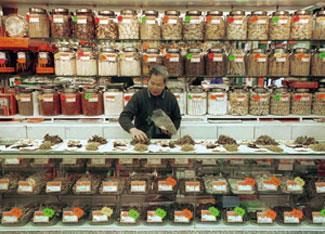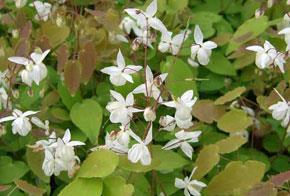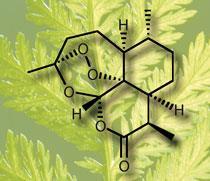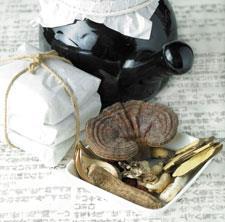The past decade has seen a global awakening to the truly curative powers of many ancient medicines, from black bear bile to the Asian plant Epimedium. Lisa Melton delves deeper
The past decade has seen a global awakening to the truly curative powers of many ancient medicines, from black bear bile to the Asian plant Epimedium. Lisa Melton delves deeper

Drug discovery is buzzing with new formulations uncovered in Chinese Medicine chests and African healers’ potions. Armed with biotech expertise and data-mining tools, today’s medicinal chemists are unlocking the molecular secrets in traditional remedies. A new wave of drugs and drug candidates are coming online that are more potent and targeted than the original remedies and promise to treat everything from malaria and tuberculosis to Alzheimer’s disease, diabetes and ageing.
But taming wild medicine into western-style formats is no mean feat. Botanicals and animal extracts are fiendishly complicated, and shaping them into conventional therapies is challenging the rules of mainstream drug discovery.
For Singaporean scientist Yong Eu Leong, whose aim is to find a herbal treatment for menopausal symptoms, there are strong parallels between ethnomedicines and wines. ’Take a bottle of Chat?au Lafite and you can track its history, the content of tannins and alcohol: you can be confident of its quality. We want the same thing for our product.’
Yong’s exploration began seven years ago with Epimedium, a ubiquitous plant used in Asia for millennia. ’Right now, the recommendation for women is no hormone replacement therapy; there are limited options,’ says Yong, a gynaecologist and researcher at Singapore’s National University Hospital. ’Many women turn to botanical alternatives without proof of safety and efficacy.’

In traditional Chinese medicine (TCM), Epimedium is considered an aphrodisiac and internet sites advertise it as herbal Viagra. Its colloquial name is ’horny goat’s weed’ because, it is said, male goats grazing on the herb display excessive copulating behaviour.
At first, Yong was reluctant to pursue this line of research. ’I wasn’t a believer in herbs, but one of my postdocs was,’ he admits. The young scientist tested the alcohol extracts from boiled, raw leaves and found them to be strongly oestrogenic. In cell-based assays, and in rats, the botanical preparation was as potent as oestradiol itself.
Yong recruited a team of chemists to elucidate which compounds in Epimedium were doing the job. The active principal is a novel prenyl-flavone - breviflavone B. Although similar to other phytooestrogens, its prenyl group - formed from isoprene (2-methyl-1,3-butadiene) units - gives it a leg up over other molecules. This group ensures that Breviflavone B is absorbed from the digestive tract while other active isoflavones such as genistein in soya fail to enter circulation.
In human studies, however, the extracts have proved disappointing. Improving the purification methods could improve results, Yong believes. ’There is a need for blending, just like wines, to get a standardised extract.’
In China, although Epimedium plants are harvested in the wild, the material on sale is often a mixture of low-quality species. Yong is determined to upgrade this herb formulation to the standards expected in western medicine. He has applied genetic and chemical profiling to classify Epimedium and is currently working with commercial partners to grow, harvest and process this herb under rigorous conditions. ’We want the consumer who takes it to know it is like aspirin: a thoroughly understood product,’ he adds.
Malaria marvel
TCM is commonly stigmatised in the West, yet it has provided the basis for some successful western medicines. Ephedrine, prescribed for the treatment of bronchial asthma, was derived from traditional Chinese medicine. This amphetamine-like stimulant isolated from mahuang (Ephedra sinica) was the first Chinese herbal remedy to enter the western pharmacopoeia.

Artemisinin, an anti-malarial drug, is another example of successful drug discovery instigated by Chinese medicine. In the 1970s, during Chairman Mao’s Cultural Revolution, young scientists uncovered the astonishing powers of the traditional herb qinghao or Artemisia annua (sweet wormwood) as a cure for malaria.
The powers of artemisinin were remarkable and soon caught the attention of western scientists. ’Towards the millennium, a dramatic medical emergency had arisen throughout Africa, Asia and South America,’ explains Marco Corsi, medical director of R&D at Sigma-Tau, in Rome, Italy. Parasite resistance to conventional drugs was rife, raising the spectre of untreatable malaria.
China, with the discovery of artemisinin, instilled new hope. In the 1990s, a Beijing-based pharmaceutical company called Cititec, together with Novartis, began developing the antimalarial mefloquine combined with artemisinin. This combination treatment, marketed with the name Coartem, proved extraordinarily effective at controlling malaria and is now recommended by the World Health Organization.
Sigma-Tau is marketing a rival artemisinin-based formulation. In partnership with the non-profit organisation Medicines for Malaria Venture based in Geneva, Switzerland, the company has developed Eurartesim, which combines dihydroartemisinin and the classical antimalarial piperaquine.
This so-called artemisinin-based combination therapy is 95-98 per cent effective, and its convenient three-day regime boosts compliance. So far, there are no signs of resistance from the parasite to artemisinin-based drugs. ’These compounds are a jewel to be protected as much as we can,’ says Sigma-Tau’s Corsi.
Gall bladder gem
Ingredients in a typical Chinese apothecary are not solely botanical - up to 13 per cent come from animals. Tiger bones to treat arthritis, slow loris eyeballs for love potions, rhinoceros horn to cure fever and delirium, and civet cat’s anal scent gland to induce abortion, for instance. The soaring trade in Chinese medicines threatens many of these species and much would be gained from finding synthetic alternatives.

Most coveted of all, perhaps, is black bear bile. In China, it is often sold in jewellery stores, and, gram for gram, the powder commands 20 times the street price of cocaine.
Black bear bile and gall bladder is recommended as a liver tonic and to treat everything from pain to cancer - its healing powers are near-mythical.
But there is more to bear bile than mere hearsay, according to G?khan Hotamisligil from the Harvard School of Public Health, Boston, US. The gall bladder of these formidable predators contains a chemical that can treat obesity-related diabetes in mice, the Harvard researcher has found.
At least 1.1 billion adults and 10 per cent of children around the world are now overweight or obese, according to the International Obesity Task Force. As more people become heavier, they become vulnerable to type 2 diabetes, a potentially fatal condition. Hotamisligil’s investigations have uncovered the key pathway that leads to diabetes.
Obesity makes unusual demands on fat cells - they become stressed. When a person piles on the pounds, a cellular organelle called the endoplasmic reticulum (ER) is forced to work harder than usual to process the surplus fat. To cope with the extra workload, the ER normally counts on a built-in pack of chemical chaperones that help process fats and proteins.
But if the ER still feels the strain, it starts faltering, igniting a chain reaction that eventually shuts down insulin pathways and precipitates diabetes. The Harvard team hopes to prevent ER stress by supplying cells with extra chaperones. They tried supplying the ER with tauro ursodeoxycholic acid (TUDCA) and another small molecular drug PBA (4-phenyl butyric acid) as potential chaperones in two sets of obese mice.
The results were pretty spectacular: the compounds alleviated ER stress, and after one week of treatment, glucose levels in both sets of obese mice returned to normal. There was a benign effect on the liver too, reducing the presence of fatty deposits that often lead to cirrhosis.
Black bears churn out tremendous amounts of TUDCA in bile, Hotamisligil found, which seems to validate many of the claims made by traditional practitioners. The good news is that it is possible to spare these formidable animals. In the West, the chemical TUDCA is already prescribed for patients with human cholestatic liver disease and has a proven safety record in people. And PBA, a compound with similar actions, has been approved by the US Food and Drug Administration for treating urea-cycle disorders in humans.
’If these compounds work in humans as they do in experimental models, they could dramatically change the approaches to treat many components of metabolic syndrome,’ Hotamisligil told delegates at a Novartis Foundation symposium in Beijing, China in October 2006.
Treasure trove
As pharmaceutical companies face shrinking pipelines, Chinese medicine has emerged as an invaluable source for drug discovery. A group of researchers at King’s College, London has undertaken the biggest study yet of the main ingredients in TCM and used computers to screen for their potential to treat HIV/Aids, cancer, Alzheimer’s disease, arthritis and other diseases. ’We first took information published in mainstream scientific journals and stitched it all together,’ says biochemist David Barlow, who credits research student Thomas Ehrman with the idea.

Erhman built a database of information on over 8000 phytochemical compounds from 240 of the most commonly used herbs in Chinese medicine. A second database of almost 2600 known active plant chemicals then became a training set for the Random Forest computer algorithm.
This virtual screening algorithm, a type of decision tree, allowed the researchers to test TCM herbs in silico against various drug targets - mostly enzymes associated with pathogens or chronic disease. ’The aim was to apply modern techniques to mine the information available to unearth those herbs most likely to provide new therapeutics,’ says Barlow. Of the 240 herbs sampled, 62 per cent had constituents that could be useful in treating one of the targets.
Modern screening efforts are likely to bump up the transfers from Chinese and folk medicine to western medicine. The London group aims to uncover new classes of drugs to combat diseases where western medicine is failing - for example, parasites and bacteria resistant to drugs currently on the market. ’We now hope to progress this in a western manner using the Chinese herbs as a pool for fishing to find new drugs,’ says Barlow.
Witch doctors
In the fight against tuberculosis, traditional African medicine is yielding valuable clues for new therapies. Clifton Barry from the National Institute of Allergy and Infectious Diseases in Bethesda, Maryland, US, is collaborating with Nigeria’s National Institute for Pharmaceutical Research and Development to interview traditional healers throughout Nigeria.
The outcome is a promising collection of plants with anti-tubercular activity which Barry and colleagues are screening for their ability to wipe out mycobacteria. ’This can be done rapidly with transcriptional profiling, using microarrays,’ says Barry. ’You just throw the crude extract directly at the bacteria. If an agent acts the same way in a microarray as another known major inhibitor, we can tell rapidly - if it doesn’t, we have a novel target.’
As 70 per cent of the Nigerian population obtain their primary medical care from traditional healers, this could be the largest clinical trial in the history of natural agents against TB, says Barry.
The ’high-information content screening’ approach takes only one or two months - a remarkable improvement over the traditional method of isolating the active principal and identifying the target, which can consume up to two years. ’Our method allows you to rule out or home in on things very rapidly,’ Barry points out.
At the Hong Kong University of Science and Technology (HKUST), researchers are also engaged in shaping traditional treatments into western-style pharmaceuticals. The HKUST Biotechnology Research Institute teamed up with Geron Corporation of Menlo Park, California, US, to find compounds that would activate telomerase as an anti-ageing agent. Their joint venture, TA Therapeutics, screened more than 50 Chinese medicines and identified several promising compounds. Pre-clinical studies are ongoing towards the goal of filing an Investigational New Drug in the US, says Nancy Ip, director of HKUST Biotechnology Research Institute.
The scientists are also investigating the herb Huperzia serrata as the basis for a potential treatment for Alzheimer’s disease. The active molecule, isolated from the herb huperzine, is a reversible acetylcholinesterase inhibitor. In its dimeric form, Ip explains, the compound boosts rats’ memories in standard water maze tests.
Ip is thrilled by the awakening she has witnessed over the past decade to the wealth contained in ancient medical knowledge. ’Many companies overseas are fascinated by the potential that Chinese medicine has to offer.
It’s an amazing opportunity to identify and isolate these new compounds and understand the mechanisms.’
As 2000-year old remedies promise to tackle some of the West’s emerging public health threats, perhaps an inspirational glass of Chat?au Lafite is in order.
Lisa Melton is science writer at the Novartis Foundation in London, UK
Further Reading
- U ?zcan et al, Science, 2006, 313, 1137
- T M Ehrman et al, J. Chem. Inf. Model, 2007, 47, 264
- H I M Boshoff et al, J. Biol. Chem., 2004, 279, 40174
Investing in tradition
The Chinese government recently announced a 15-year development plan to boost research into traditional Chinese medicine (TCM). The project has the backing of 16 Chinese ministries, including the Ministry of Science and Technology, the Ministry of Health, and the State Administration of Traditional Chinese Medicine.The plan was revealed at the end of March at the launch of a new report entitled Outline for innovative development of TCM. The Chinese government is reported to have earmarked substantial sums of money for TCM research and development. It will focus on improving modern TCM manufacturing techniques and creating a set of internationally recognisable TCM standards.






No comments yet